Saffir-Simpson Hurricane Scale
| Saffir-Simpson Hurricane Scale | ||||
|---|---|---|---|---|
| Category | Wind speed | Storm surge | ||
| mph (km/h) |
ft (m) |
|||
| 5 | ≥156 (≥250) |
>18 (>5.5) |
||
| 4 | 131–155 (210–249) |
13–18 (4.0–5.5) |
||
| 3 | 111–130 (178–209) |
9–12 (2.7–3.7) |
||
| 2 | 96–110 (154–177) |
6–8 (1.8–2.4) |
||
| 1 | 74–95 (119–153) |
4–5 (1.2–1.5) |
||
| Additional classifications | ||||
| Tropical storm |
39–73 (63–117) |
0–3 (0–0.9) |
||
| Tropical depression |
0–38 (0–62) |
0 (0) |
||
The Saffir-Simpson Hurricane Scale is a classification used for most Western Hemisphere tropical cyclones that exceed the intensities of tropical depressions and tropical storms, and thereby become hurricanes. The scale divides hurricanes into five categories distinguished by the intensities of their sustained winds. In order to be classified as a hurricane, a tropical cyclone must have maximum sustained winds of at least 74 mph (33 m/s; 64 kt; 119 km/h). The highest classification in the scale, Category 5, is reserved for storms with winds exceeding 155 mph (69 m/s; 136 kt; 249 km/h).
The classifications are intended primarily for use in measuring the potential damage and flooding a hurricane will cause upon landfall, although they have been criticized as being too simple. Officially, the Saffir-Simpson Hurricane Scale is used only to describe hurricanes forming in the Atlantic Ocean and northern Pacific Ocean east of the International Date Line. Other areas use different classification scales to label these storms, which are called "cyclones" or "typhoons", depending on the area.
Contents |
History
The scale was developed in 1971 by civil engineer Herbert Saffir and meteorologist Bob Simpson, who at the time was director of the U.S. National Hurricane Center (NHC).[1] The scale was introduced to the general public in 1973,[2] and saw widespread use after Neil Frank replaced Simpson at the helm of the NHC in 1974.[3]
The initial scale was developed by Saffir, a structural engineer, who in 1969 went on commission for the United Nations to study low-cost housing in hurricane-prone areas.[4] While performing the study, Saffir realized there was no simple scale for describing the likely effects of a hurricane. Mirroring the utility of the Richter magnitude scale in describing earthquakes, he devised a 1–5 scale based on wind speed that showed expected damage to structures. Saffir gave the scale to the NHC, and Simpson added the effects of storm surge and flooding. The scale does not take into account rainfall or location, which means a Category 2 hurricane which hits a major city will likely do far more damage than a Category 5 hurricane that hits a rural area.[5]
Categories
The scale separates hurricanes into five different categories based on wind, central barometric pressure, and storm surge. The U.S. National Hurricane Center classifies hurricanes of Category 3 and above as major hurricanes. Most weather agencies use the definition for sustained winds recommended by the World Meteorological Organization (WMO), which specifies measuring winds at a height of 33 ft (10 m) for 10 minutes, and then taking the average. By contrast, the U.S. National Weather Service defines sustained winds as average winds over a period of one minute, measured at the same 33 ft (10 m) height.[6][7] Central pressure values are approximate. Intensity of example hurricanes is from both the time of landfall and the maximum intensity.[8]
The scale is roughly logarithmic in wind speed, and the top wind speed for Category "c" (c=1, 2, 3, or 4) can be expressed as  miles per hour rounded to the nearest multiple of 5.
miles per hour rounded to the nearest multiple of 5.
The five categories are, in order of increasing intensity:
Category 1
| Category 1 | ||||
|---|---|---|---|---|
| Sustained winds | 33–42 m/s | 64–82 kt | 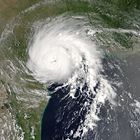 Claudette near landfall |
|
| 119–153 km/h | 74–95 mph | |||
| Storm surge | 1.2–1.5 m | 4–5 ft | ||
| Central pressure | 980–989 mbar | 28.94 inHg | ||
Category 1 storms usually cause no significant damage to building structures; however, they can tip over unanchored mobile homes, as well as uproot or snap trees. Poorly attached roof shingles or tiles can blow off. Also, they produce some coastal flooding, as well as minor pier damage.[8]
Examples of storms of this intensity include: Hurricane Alice (1954), Danny (1985), Jerry (1989), Ismael (1995), Gaston (2004), Humberto (2007), and Hanna (2008).
Category 2
| Category 2 | ||||
|---|---|---|---|---|
| Sustained winds | 43–49 m/s | 83–95 kt | 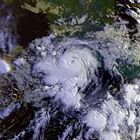 Alma approaching land |
|
| 154–177 km/h | 96–110 mph | |||
| Storm surge | 1.8–2.4 m | 6–8 ft | ||
| Central pressure | 965–979 mbar | 28.50–28.91 inHg | ||
Storms of this intensity damage some roofing material, and also produce damage to poorly constructed doors and windows. Considerable damage is caused to vegetation, poorly constructed signs, and piers. Mobile homes, whether anchored or not, are usually badly damaged, and many manufactured homes also suffer structural damage. Also, small craft in unprotected anchorages may break their moorings.[8]
Hurricanes that peaked at Category 2 intensity, and made landfall while still in that category include Carol (1954), Diana (1990), Erin (1995), Alma (1996), Marty (2003), Juan (2003).
Category 3
| Category 3 | ||||
|---|---|---|---|---|
| Sustained winds | 50–58 m/s | 96–113 kt | 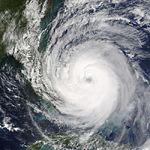 Jeanne over the Bahamas |
|
| 178–209 km/h | 111–130 mph | |||
| Storm surge | 2.7–3.7 m | 9–12 ft | ||
| Central pressure | 945–964 mbar | 27.91–28.47 inHg | ||
Tropical cyclones of this intensity and higher receive the name of major hurricanes when located in the Atlantic or Eastern Pacific basins. These storms can cause some structural damage to small residences and utility buildings, particularly those of wood frame or manufactured materials with minor curtainwall failures. Buildings that lack a solid foundation, such as mobile homes, are usually destroyed, and gable-end roofs are peeled off. Manufactured homes usually sustain very heavy and irreparable damage. Flooding near the coast destroys smaller structures, while larger structures are hit by floating debris. Additionally, terrain may be flooded well inland.[8]
Examples of storms of this intensity include Alma (1966), Alicia (1983), Fran (1996), Isidore (2002), Jeanne (2004), Lane (2006), and Bertha (2008).
Category 4
| Category 4 | ||||
|---|---|---|---|---|
| Sustained winds | 59–69 m/s | 114–135 kt | 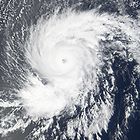 Flossie in the Central Pacific |
|
| 210–249 km/h | 131–155 mph | |||
| Storm surge | 4.0–5.5 m | 13–18 ft | ||
| Central pressure | 920–944 mbar | 27.17–27.88 inHg | ||
- See also: List of Category 4 Atlantic hurricanes
Category 4 hurricanes tend to produce more extensive curtainwall failures, with some complete roof structural failure on small residences. Heavy, irreparable damage and near complete destruction of gas station canopies and other wide span overhang type structures are also common. Mobile and manufactured homes are leveled. These hurricanes cause major erosion of beach areas and terrain may be flooded well inland as well.[8]
Hurricanes of this intensity are extremely dangerous to populated areas. Hurricane Ike was the most destructive Category 4 tropical cyclone in recorded history, causing damage in excess of $31.5 billion (2008 USD). With a storm surge of a Category 5 height though the windspeeds were that of a Category 2-3, Ike brought on the greatest recorded storm surge of any Category 4 Altantic tropical cyclone. Ike also went on to become the most massive Altantic tropical cyclone ever recorded. Use of radius of outermost closed isobar statistics indicate that Hurricane Ike was the largest tropical cyclone ever observed in the Atlantic basin.[9] The Galveston Hurricane of 1900, the deadliest natural disaster to hit the United States, would be classified as Category 4 if it occurred today. Other examples of storms at this intensity are Hazel (1954), Carmen (1974), Iniki (1992), Luis (1995), Iris (2001), Charley (2004), Gustav, Ike, Omar, and Paloma (all 2008).
Category 5
| Category 5 | ||||
|---|---|---|---|---|
| Sustained winds | ≥70 m/s | ≥136 kt | 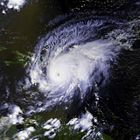 David in the Caribbean Sea |
|
| ≥250 km/h | ≥156 mph | |||
| Storm surge | ≥5.5 m | ≥19 ft | ||
| Central pressure | <920 mbar | <27.17 inHg | ||
- See also: List of Category 5 Atlantic hurricanes and List of Category 5 Pacific hurricanes
Category 5 is the highest category a tropical cyclone can obtain in the Saffir-Simpson scale. These storms cause complete roof failure on many residences and industrial buildings, and some complete building failures with small utility buildings blown over or away. Collapse of many wide-span roofs and walls, especially those with no interior supports, is common. Very heavy and irreparable damage to many wood frame structures and total destruction to mobile/manufactured homes is prevalent. Only a few types of structures are capable of surviving intact, and only if located at least three to five miles (four to eight km) inland. They include office, condominium and apartment buildings and hotels that are of solid concrete or steel frame construction, public multi-story concrete parking garages, and residences that are made of either reinforced brick or concrete/cement block and have hipped roofs with slopes of no less than 35 degrees from horizontal and no overhangs of any kind, and if the windows are either made of hurricane resistant safety glass or covered with shutters.[8]
The storm's flooding causes major damage to the lower floors of all structures near the shoreline, and many coastal structures can be completely flattened or washed away by the storm surge. Storm surge damage can occur up to four city blocks inland, with flooding, depending on terrain, reaching six to seven blocks inland. Massive evacuation of residential areas may be required if the hurricane threatens populated areas.[8]
Storms of this intensity can be severely damaging. Historical examples that reached the Category 5 status and made landfall as such include the Labor Day Hurricane of 1935, the 1959 Mexico Hurricane, Camille in 1969, Gilbert in 1988, Andrew in 1992, and Dean and Felix (2007).
Criticism
Some scientists, including Kerry Emanuel and Lakshmi Kantha, have criticized the scale as being too simplistic, indicating that the scale does not take into account the physical size of a storm, nor the amount of precipitation it produces.[5] Additionally, they and others point out that the Saffir-Simpson scale, unlike the Richter scale used to measure earthquakes, is not open-ended, and is quantized into a small number of categories. Proposed replacement classifications include the Hurricane Intensity Index, which is based on the dynamic pressure caused by a storm's winds, and the Hurricane Hazard Index, which bases itself on surface wind speeds, the radius of maximum winds of the storm, and its translational velocity.[10][11] Both of these scales are continuous, akin to the Richter scale;[12] however, neither of these scales have been used by officials.
Category 6
After the string of powerful storm systems of the 2005 Atlantic hurricane season, a few newspaper columnists and scientists brought up the suggestion of introducing Category 6, and they have suggested pegging Category 6 to storms with winds greater than 175 or 180 mph (78–80 m/s; 150–155 knots; 280–290 km/h).[5][13] Only a few storms in history have reached into this hypothetical category. Most of these storms were west pacific Super Typhoons; most notably Typhoon Tip in 1979 with sustained winds of over 195 mph.
According to Robert Simpson, there is no reason for a Category 6 on the Saffir-Simpson Scale because it is designed to measure the potential damage of a hurricane to human-made structures.[3] If the wind speed of the hurricane is above 156 mph (250 km/h), then the damage to a building will be "serious no matter how well it's engineered". However, the result of new technologies in construction leads some to suggest that an increase in the number of categories is necessary.
See also
- Beaufort scale – For winds less intense than hurricane strength.
- Fujita scale – For tornado intensity with damage correlated to wind speeds. The system was also intended for applicability in hurricanes and indeed is utilized by engineers in hurricane damage assessment.
- Severe weather terminology
- List of tropical cyclones
- List of Category 5 Atlantic hurricanes
- List of Category 5 Pacific hurricanes
References
- ↑ Williams, Jack (May 17, 2005). "Hurricane scale invented to communicate storm danger", USA Today. Retrieved on 2007-02-25.
- ↑ Staff writer (May 9, 1973). "'73 Hurricanes to be Graded". The Associated Press. Retrieved on 2007-12-08.
- ↑ 3.0 3.1 Debi Iacovelli (July 2001). "The Saffir/Simpson Hurricane Scale: An Interview with Dr. Robert Simpson". South Florida Sun-Sentinel. Retrieved on 2006-09-10.
- ↑ Associated Press (2001-08-13). "Hurricanes shaped life of scale inventor Saffir". Retrieved on 2007-12-21.
- ↑ 5.0 5.1 5.2 Ker Than (2005-10-20). "Wilma's Rage Suggests New Hurricane Categories Needed", LiveScience. Retrieved on 2005-10-20.
- ↑ Tropical Cyclone Weather Services Program (June 1, 2006). "Tropical cyclone definitions" (PDF). National Weather Service. Retrieved on 2006-11-30.
- ↑ Federal Emergency Management Agency (2004). "Hurricane Glossary of Terms". Retrieved on 2006-03-24. Accessed through the Wayback Machine.
- ↑ 8.0 8.1 8.2 8.3 8.4 8.5 8.6 National Hurricane Center (June 22, 2006). "Saffir-Simpson Hurricane Scale Information". National Oceanic and Atmospheric Administration. Retrieved on 2007-02-25.
- ↑ Masters, Jeff (2008-09-12). "Ike's record size.". Weather Underground. Retrieved on 2008-09-27.
- ↑ Kantha, L. (January 2006). "Time to Replace the Saffir-Simpson Hurricane Scale?" (PDF). Eos 87 (1): 3,6. http://www.ametro.net/~spongey/images/2006EO010003.pdf. Retrieved on 2007-12-08.
- ↑ Kantha, Lakshmi (February 2008). "Tropical Cyclone Destructive Potential by Integrated Kinetic Energy" (PDF). Bulletin of the American Meteorological Society (Boston: American Meteorological Society) 89 (2): 219–221. doi:. http://ams.allenpress.com/archive/1520-0477/89/2/pdf/i1520-0477-89-2-219.pdf. Retrieved on 2008-08-19.
- ↑ Benfield Hazard Research Centre (2006). "Atmospheric Hazards". Hazard & Risk Science Review 2006. University College London. Retrieved on 2007-12-08.
- ↑ Bill Blakemore (2006-05-21). "Category 6 Hurricanes? They've Happened: Global Warming Winds Up Hurricane Scientists as NOAA Issues Its Atlantic Hurricane Predictions for Summer 2006", ABC News. Retrieved on 2006-09-10.
External links
- An Interview with Dr. Robert Simpson - The Mariners Weather Log, April 1999
- Q&A with Herbert Saffir - The South Florida Sun-Sentinel, June 2001